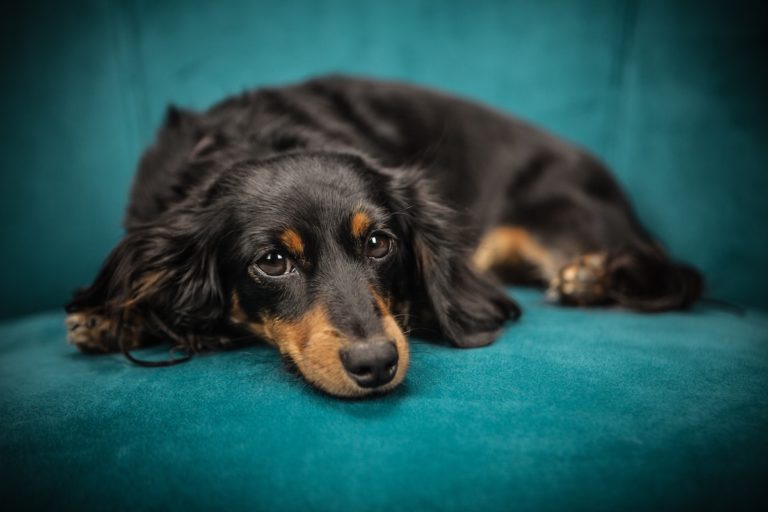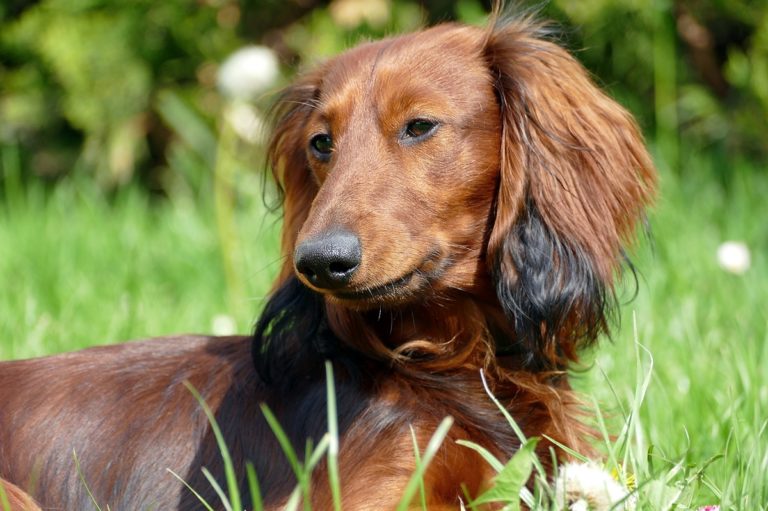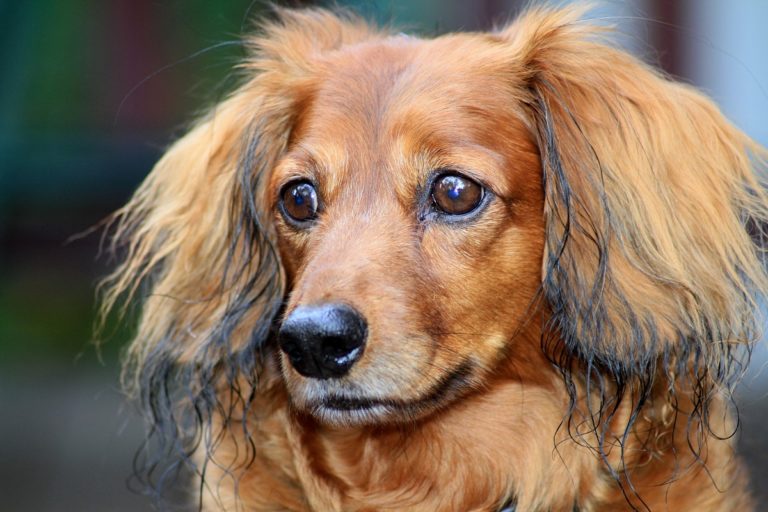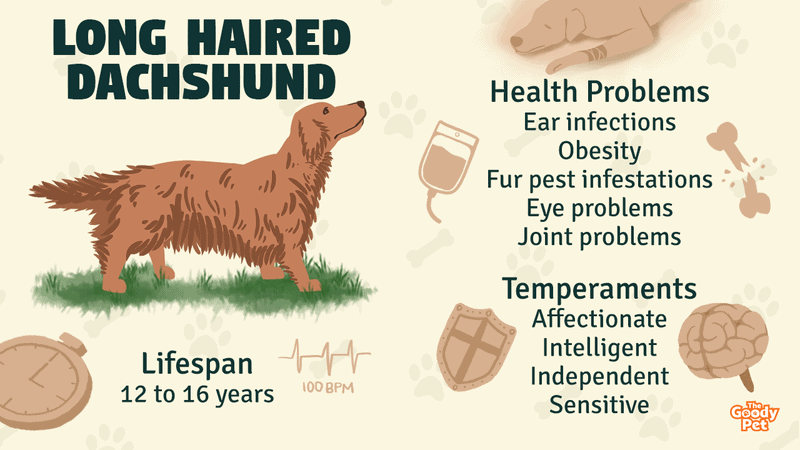Dachshunds are absolutely adorable whether it is a mini or standard-sized pet, with short or long hair.
For a long time, I didn’t know that Long Haired Dachshunds were a thing. I just assumed it was a regular Doxie that was in desperate need of a trim.
This is a common mistake, especially with newbie Dachshund owners. To help you out, let us take a look at this variety and what it means to be a Long Haired Dachshund.
The Long Haired Dachshund is one of the three coat type variants that Dachshunds come in. It is characterized by long, silky smooth fur over most of the body and shorter, feathery strands on the legs and ears.
The shortest fur on these dogs appears on the face, but when untrimmed, it still tends to grow longer than what you would see in a Short Haired Dachshund. It is relatively common when it comes to Dachshunds but not as much as the short, smooth haired variety.
For the most part, long haired Doxies are like the common short haired ones in terms of size, temperament, and care needs. However, with the long mane come a few differences in the experience you can expect as a dog owner. Let’s dive right into it so that you know exactly what you are getting yourself into.
How Did Dachshunds Get Long Hair?

Like pretty much any other characteristic on a Dachshund, the type of coat is genetically determined. Don’t worry, we won’t get too technical with the genetics of dog coat characteristics. However, a basic understanding of the science will definitely come in handy when it comes to understanding the dog and its needs.
The first important gene is the one that determines the length of the fur. With Dachshunds, shorter hair is determined by a dominant gene which means that only one copy is required for its manifestation. Long fur on the other hand is determined by a recessive gene. This means that you either need two long haired Doxies or carriers of the recessive gene to get this trait.
The second gene determines whether the fur is wiry or straight. The straight trait is a result of the “non-wired fur gene.” This is also a recessive gene variation that requires two copies to be manifested.
Therefore, in order to produce a Long Haired Dachshund, the genetic makeup needs to feature the long hair and non-wired fur genetic variants in combination. The result is the single layer coat of long and silky fur which can either be completely straight or slightly wavy.
The other Dachshund coat type variations are the short haired and the wiry haired types. The short haired Doxie has a combination of the dominant short fur gene and the recessive non-wiry gene. The Wiry Haired Dachshund, on the other hand, has the recessive long fur gene and the dominant wiry fur gene for the long and coarse coat type.
Do Long Haired Dachshunds Shed More Than Short Haired?

Long Haired Dachshunds are not considered hypoallergenic so if you live with or regularly host people with dog allergies you will have to take specific measures to make them good family pets. These doggies are moderate shedders. However, with good grooming practices you can keep them from shedding too much.
A common misconception when it comes to raising Long Haired Dachshunds is that they shed more than shorter haired and wiry Doxies. This is not always the case. It is actually due to the long nature of the fur, which makes the shedding appear more dramatic in volume than it really is.
However, this is not to say that Long Haired Dachshunds are not problematic to raise. In fact, if you do not take care of the coat properly, you will end up with a matted mess. This usually happens as a result of knots forming in various spots, including the ears, tail, and feet. If not combed out, they accumulate dirt and grime and form mats.
The best way to combat this, as well as excessive shedding, is by regularly brushing your weenie. With long haired ones, it is best to do this 3 times a week at the very least. Brushing helps to detangle knotted fur and prevent matting. It also allows you to get rid of loose hair to minimize shedding around your home.
You can also reduce the amount of fur in your home by vacuuming or using specific hair remover rollers. With the latter, the DELOMO Pet Hair Remover Roller is your best bet for a fur-free home. The reusable roller will help you get rid of fur everywhere, from furniture to your clothes.
Are Long Haired Dachshunds High Maintenance? Long Haired Dachshund Grooming Tips
It is a common belief among dog owners and potential pooch parents that dogs with longer fur are high maintenance. The Long Haired Dachshund is not spared when it comes to this stereotype. However, they are surprisingly easy to take care of and are, in fact, lower maintenance than other Dachshund varieties like the wiry haired type.
One tip to help you minimize your maintenance needs is to not only brush on a regular basis but also to use high-quality equipment. This reduces the amount of matting and shedding that can make taking care of the dogs problematic.
Stick to a 2 to 3 days a week schedule, and you should be just fine. When it comes to brushes, the Poodle Pet Detangling Pet Comb stands out with its combination of long and short comb teeth for effective brushing and rounded tips for your pooch’s safety.
It is very likely for your Long Haired Dachshund to smell more than shorter haired varieties because of all the space that odors and the germs producing them have to hide in. Consider using dog deodorant products, whether it is wipes or scented essential oil sprays. Your pooch will also benefit from a bath every month or two to help keep the nastiness at bay.
As expected, Long Haired Dachshunds need regular haircuts to avoid getting swallowed up by their thick manes. However, the fur does not grow excessively fast, so you can get away with scheduling a trim every 4 to 6 months, depending on how long you want it.
Common Health Problems Of Long Haired Dachshunds
When it comes to health issues, there is still a lot of debate as to whether having long hair makes Dachshunds more prone to certain conditions. There are a mere few where the evidence of direct correlation exists, while others are just theoretic. Whichever the case, these Doxies suffer more or less the same conditions as their short haired and wiry haired counterparts. Here are some of these conditions.
Ear Infections
Dachshunds have long and droopy ears, which are already alone a risk factor for ear infections. With the long fur offering additional warmth, moisture trapping, and darkness, the incidences of these infections will only increase.
Fur Pest Infestations
Pests like fleas and mites also thrive in the thick and long cover offered by this coat type. This is associated with issues like contact dermatitis, such that, if not handled correctly, it can lead to complications like skin infections and fur loss.
Joint Problems
These are common with all Doxies and include hip and shoulder dysplasia as well as patellar luxation. With proper supplementation and a calcium-rich diet, the effects of these conditions can be controlled.
Obesity
This is associated with their high appetite and occasional mobility issues due to skeletal problems. Obesity can lead to other conditions like diabetes and cardiac diseases that often have fatal consequences.
Eye Problems
The most common issues here include progressive retinal atrophy and cataracts. These eventually lead to blindness which negatively impacts the dog’s quality of life.
Heart Disease
Studies have shown a higher prevalence of heart diseases, including valvular failure, in older Long Haired Dachshunds than the other two coat variants. These diseases eventually lead to death.
Back Problems
Intervertebral disc disorder affects all Doxies equally and is related to the short stature and disproportionately long torso.
Consider getting a dog back brace for to alleviate your dog’s life with IVDD. The L’il Back Bracer Dog Back Brace will help give your pooch some relief from the pain and limited mobility caused by the condition.
Long Haired Dachshund Temperament Guide
There are a few subtle differences noticeable in terms of temperament if you compare the Long Haired Dachshund with the other coat types. For more perspective, here are the most common personality traits to expect from these doggies.
Affectionate
Long haired Doxies love to cuddle and sit on the laps of people that they love and trust. They are generally very friendly and loving, which makes them fantastic family pets.
Intelligent
They are also considerably more intelligent and less stubborn than other Doxies with different coat types. This makes them easier to train and less likely to suffer aggressive outbursts.
Confident
Like any other Dachshunds, these long haired beauties are incredibly confident and brave. They love to explore and are never afraid to try new games, meet new people, or enjoy unfamiliar environments. However, socialization is required to ensure this goes smoothly.
Independent
Long haired weenies are also known for being the least clingy of the three coat type Dachshunds. You can thus easily leave your pooch home alone without worrying too much about some of the separation anxiety-related outbursts associated with the other two.
Sensitive
Despite being significantly calmer and more confident, these dogs have a sensitive side and particularly do not like to be treated aggressively. Instead, they respond great to praise and rewards which is an important consideration in making dog training a breeze.
Calmer And More Obedient

These doggies are also fantastic if you want a calm and obedient Doxie that actually does what is expected of them. With them, you rarely have to deal with issues like unnecessary barking.
Related Questions
How To Tell If A Dachshund Puppy Is Long Haired? It is not always easy to pick out the coat type of a Dachshund when it is a young puppy, as they sometimes all look the same. However, as they grow older, the differences become more prominent. Long Haired Dachshunds are known for their long and silky smooth fur that lies close to the skin. It can either be straight or wavy but never curly.
Are Long Haired Dachshunds More Expensive? For the most part, Long Haired Dachshunds lie within the same $400 to $1,100 price range as the other Dachshund coat types. However, they are rarer than the short haired type and preferred for their aesthetics and can therefore cost you up to $1,500 if bought from some breeders out there.
What Is The Lifespan Of A Long Haired Dachshund? Long Haired Dachshunds have a lifespan of 12 to 16 years which is the same range as the other two. This is because they have the same build and suffer more or less the same health issues. So with proper nutrition and care, your long haired Doxie should live a full and happy life like the other two types.





